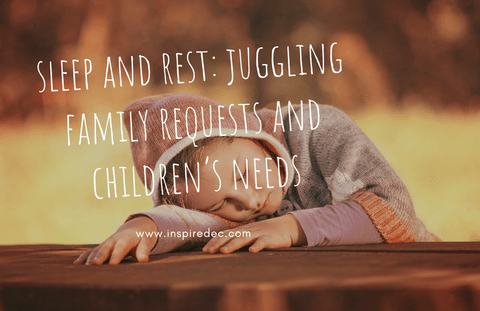
Table of Contents
It sounds like it should be pretty straightforward, right? If a child is tired, they sleep. But what happens when a family says, “Please don’t let my child sleep or they are up until midnight”? How do we, as educators, juggle the needs of the child and the requests of the family?
Understanding the Needs of the Child
What does the child need? Are they falling asleep at the lunch table? Then they definitely need sleep. Are they falling asleep because they are being made to rest on a bed and be quiet for an hour? They may not need sleep – they may be falling asleep out of boredom or because they feel it is expected of them.
According to Children’s Health QLD, in general, children have a daily requirement for sleep:
- Infants (4-12 months)—12 to 16 hours per day (including naps)
- Toddlers (1-2 years)—11 to 14 hours per day (including naps)
- Preschoolers (3-5 years)—10 to 13 hours per day (including naps)
- School Age (6-12 years)—9 to 11 hours per day
- Teens (13 to 18 years)—8 to 10 hours
There will be children in your care who do need to sleep during the day, and there will be children who don’t. The trick is identifying individual needs. This is done through observation of the child at play (do they become sleepy, yawning, irritable) and through conversation with families.
Understanding the Requests of the Family
So, a family has come to you and requested that you don’t let their child sleep, or that you wake them after 40 minutes, or that you “make” their child have a sleep. This request should not be the end of the conversation, but the beginning. Take time to listen to what is happening in the household for the family. What repercussions does the child sleeping (or not sleeping) have on the family – on the parent, on siblings, on the child themselves? Take time to understand what the request is really all about.
Advocating for the Child’s Needs
Once you have listened and understood the request, share what you are noticing in care. If you are noticing that the child is falling asleep at the table, share that. If you are noticing that they are becoming so irritable/distressed/tired in the afternoons, share that. Families don’t see what we see throughout the day—how can they?
What are the requirements?
The Education and Care Services National Regulations state (R84A) “The approved provider of an education and care service must take reasonable steps to ensure that the needs for sleep and rest of children being educated and cared for by the service are met, having regard to the ages, developmental stages and individual needs of the children.” This regulation also extends to the Nominated Supervisor, and in the instance of family day care, the educator.
Your service will also have policies outlining sleep and rest practices and requirements – be sure to refer to these.
Ultimately our focus is the child – Communication is the key
If a family asks that you don’t let their one year old sleep because they will be awake all night, that simply isn’t reasonable. That infant will probably end of crying themselves to sleep as a result of not having their needs met.
If a family asks that you keep their four year old awake, and they fall asleep at the table eating lunch, we aren’t going to shake them awake saying “Your Dad said no sleeping!!”
It is important that we create an environment, and opportunities conducive to sleep and rest, for the children that need it. It is important that we are responsive to what children need. It is important that we communicate with families honestly. You may not want to tell Sienna’s mum that she slept for two hours when she specifically said “I don’t want Sienna to sleep”, but honesty is key. Saying “Sienna grabbed a cushion off the lounge and curled up on the floor and went to sleep after lunch.” is better than pretending to have complied with the parent’s request (yes, I have seen educators do that.)
There’s no doubt that this is a constant juggle, but as advocates for children, for what they need – we must continue to juggle on!
Contribute content to Playvolution HQ
Brought to you by Explorations Early Learning
Browse Trainings

Post Author
Nicole Halton is an early childhood consultant and one of the co-founders of Inspired EC – an Early Childhood consultancy company based in Australia.Nicole has co-authored several books and developed a variety of resources for educators. Nicole and her husband live in Lake Macquarie, Australia and love spending time outdoors with their three young children.


Leave a Reply